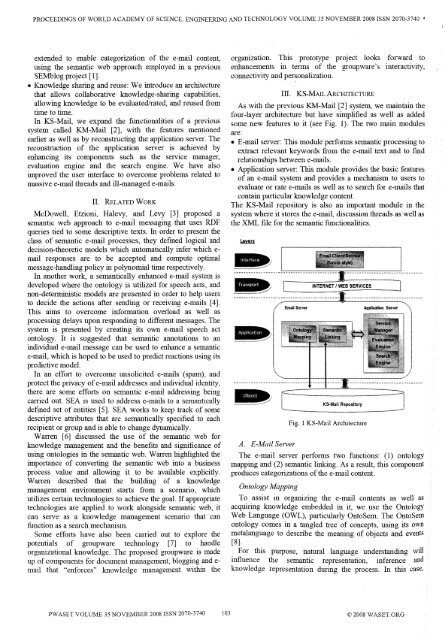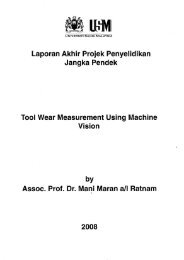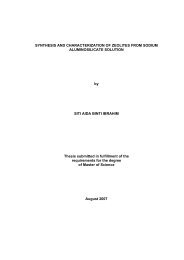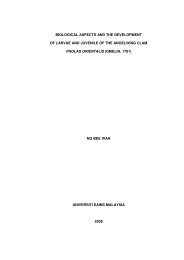A Knowledge-Based E-mail System Using Semantic ... - ePrints@USM
A Knowledge-Based E-mail System Using Semantic ... - ePrints@USM
A Knowledge-Based E-mail System Using Semantic ... - ePrints@USM
Create successful ePaper yourself
Turn your PDF publications into a flip-book with our unique Google optimized e-Paper software.
Y Y"_N· ~<br />
Y __<br />
PR()CEEI)INGS OF \V()RLD AC.A.DEMY OF SCIENCE~ ENGINEERING ALND TECHNOLOGY 'VOLlTME 35 NOVEMBER 2008 ISSN 2070-3740 f<br />
extended to enable categorization of the e-Inail content,<br />
using the semantic \veb approach employed in a previous<br />
SEMbiog project (1].<br />
• <strong>Knowledge</strong> sharing and reuse: We introduce an architecture<br />
that allows collaborative knowledge-sharing capabilities?<br />
allo\vmg kno\vledge to be evaluated/rated, and reused from<br />
tilne to time.<br />
In KS-Mail, we expand the ftmctiollalities of a previous<br />
systetTI called KM-Mail [2], \vith the features mentioned.<br />
earlier as \vell as by reconstructing the application seIVer. The<br />
reconstruction of the application server is achieved by<br />
enhancing its components such as the selVice manager,<br />
evaluation engine and the search engine. We have also<br />
unproved the user interface to overcome problems related to<br />
massive e-<strong>mail</strong> thread~ and ill-managed e-<strong>mail</strong>s.<br />
II.<br />
RELATED WORK<br />
McDo\vel1, Etzioni, Halevy, and Levy [3] proposed a<br />
setnantic web approach to e-<strong>mail</strong> luessaging that uses RDF<br />
queries tied to SOine descriptive texts. In order to present the<br />
class of semantic e-<strong>mail</strong> processes, they defined logical and<br />
decision-theoretic models which autonlatically infer ,vhich e<br />
nlail responses are to be accepted and compute optimal<br />
message-handling policy in polynomial time respectively.<br />
In another work, a semantically enhanced e-luail systelTI is<br />
developed where the ontology is utilized for speech acts, and<br />
non-deterministic models are presented in order to help users<br />
to decide the actions after sending or receiving e-<strong>mail</strong>s [4].<br />
This aims to overcome inioffilation overload as 'Yell as<br />
processing delays upon respondiIlg to different Inessages. The<br />
system is presented by creating its O\Vl1 e-<strong>mail</strong> speech act<br />
ontology. It is suggested that semantic annotations to an<br />
individual e-Inail tnessage can be used to enhance a semantic<br />
e-<strong>mail</strong>, which is hoped to be used to predict reactions using its<br />
predictive model.<br />
In an efTort to overcome unsolicited e-<strong>mail</strong>s (spam):> and<br />
protect the privacy ofe-nlail addresses and individual identitY1<br />
there are SOine efforts on semantic e-<strong>mail</strong> addressing being<br />
carried out. SE..A. is used to address e-luails to a sen1antically<br />
defined set of entities [5]. SEA works to keep track of some<br />
descriptive attributes that are semantically specified to each<br />
recipient or group and is able to change dynamically.<br />
WalTen [6] discussed the use of the senlantic web for<br />
knowledge management and the benefits and significance of<br />
using ontologies in the semantic \veb. Warren highlighted the<br />
importance of converting the selnalltic web into a business<br />
process value and allowing it to be available explicitly.<br />
Warren described that the building of a knowledge<br />
nlanagement environment starts fron1 a scenario, \vhich<br />
utilizes certain technologies to achieve the goal. Ifappropriate<br />
technologies are applied to \vork alongside sen1antic web, it<br />
can selVe as a knowledge management scenario that can<br />
fi.lnction as a search mechanisln.<br />
Some efforts have also been carried out to explore the<br />
potentials of groUP\Vare technology [7] to handle<br />
organizational knowledge. The proposed groupware is made<br />
up ofcOlnponents for dOCUlnellt Inanagement, bloggmg and e<br />
Inail that ~'enforces" kno\vledge nlanagement within the<br />
organization. This prototype project looks fonvard to<br />
enhancements in terms of the groupware's interactivity~<br />
connectivity and personalization.<br />
In. KS-MAILARCHITECTURE<br />
As with the previous KM-Mail [2] system, we maintain the<br />
four-layer architecture but have simplified as \vell as added<br />
some new features to it (see Fig. 1). The two nlain modules<br />
are:<br />
• E-<strong>mail</strong> server: This module performs selnantic processing to<br />
extract relevant keywords fronl the e-<strong>mail</strong> text and to fmd<br />
relationships bet\:veen e-nlails.<br />
• Application server: This luodule provides the basic features<br />
of an e-nlail system and provides a mec.hanism to .users to<br />
evaluate or rate e-<strong>mail</strong>s as well as to searc.h for e-Inails that<br />
contain particular kno\vledge content.<br />
The KS-Mail repository is also an ilnportant module in the<br />
system where it stores the e-Inail, discussion threads as well as<br />
the XML· file for the semantic functionalities.<br />
~,<br />
..-» ... «~~;:. ..........;N'" *#. ""' .............: ..... - ............. - ••--- v.<br />
~ [ lNTERN~;SERVlC~ .... l<br />
:;.:':'~.h:':V::":~::.::::::;·~. ,. __ ~ ------- ~ __ .~ :~ _H---I.. __ H.Y<br />
.A.<br />
E-1vfail Server<br />
_N~__UH __<br />
,//:E<strong>mail</strong> Server ..' Application Ser#!f·~'·'\~<br />
Fig. 1 KS-1tluil Architecture<br />
The e-nlail server performs t\VO functions: (1) ontology<br />
mapping and (2) semantic linking. As a result, this component<br />
produces categorizations ofthe e-<strong>mail</strong> content.<br />
Ontology lv/opping<br />
To assist in organizing the e-<strong>mail</strong> contents as well as<br />
acquiring knowledge embedded in it, we use the Ontology<br />
Web Language (OWL)~ particularly OntoSem. The OntoSem<br />
ontology comes in a tangled tree of concepts~ using its OVill<br />
metalanguage to desclibe the meaning of objects and events<br />
[8].<br />
For this purpose, natural language understanding \vill<br />
influence the semantic representation, inference and<br />
knowledge representation during the process. In this case1<br />
P\VASET VOLUlv1E 3S NOVEMBER 2008 ISSN 2070-3740 103 © 2008 \VASET,ORG

















